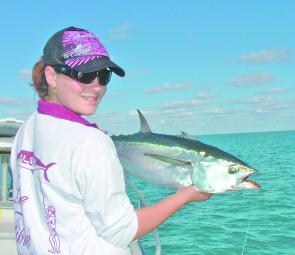To most anglers the southern Gulf port of Karumba is the gateway to great barramundi missions and nailing a feed of big grunter or fingermark. But what if the fishing gods are not smiling on you and, for whatever reason, you end up in the Gulf smack bang in the middle of winter.
During the winter months, the barra go to sleep and while the odd fish is available for the most switched on angler, they are not in the numbers that make dream trips. But do not despair! There is a little surprise packet that is not that well explored – the northern longtail tuna.
Offshore from Karumba, the commercial fleet have been netting these areas for years for shark and grey mackerel. However, they do not target the tuna so you may find yourself alone with acres of these little battlers to fight. All that is required is a decent boat and a bit of seamanship.
To get to the tuna just follow the leads from the river and head straight out from Karumba to the west. The further north you run the closer the deeper water, and by deep I mean you need 40-50ft of water before the tuna will really school up.
The tuna have been anywhere from 10-20nm out, following the bait around. With the abundant amount of run-off in the area after the wet season, there will be oodles of baitfish all cruising around being eaten at any predator’s leisure.
Depending on the conditions, the tuna can be travelling in small groups and it can be a bit frustrating when they pop-up and then disappear in a heartbeat. But other times you could catch them on a bit of string with a bent pin they are that plentiful.
The tuna may not be monsters but they certainly pull the kinks out of the line and provide great sport if the tackle is kept on the lighter side. A 10kg, 7’ spin rod with a reel that can knock up a fair retrieve is the way to go. You really can’t go past this gear for having fun on these little speedsters.
Line can be as light as the amount of time you wish to spend with the tuna circling under the boat. 20-30lb braid works just fine, any lighter and the chance of a super knot in the breeze increases dramatically. Use a small metal slice (SureCatch Gold Knights or Halco Gold Twisties work great) and retrieve as fast as you can – you cannot wind fast enough for a tuna!
Fly tackle can also be used successfully but you will more than likely need a good boat handler to get you into the casting zone with the wind over your casting arm shoulder and away from all on board.
It goes without saying that you must ‘match-the-hatch’ and use a small fly in the size range of the bait that tuna chase. A good trick is to catch one on conventional tackle first, which will normally cough up plenty of baitfish once landed, then the hatch-can-be-matched!
Tuna can be frustrating little critters that seem to blow up in the distance, feed like maniacs and disappear the minute you get your boat within casting distance.
As tuna feed into the wind, circle the school and get in front of the feeding fish then knock the boat out of gear and just drift in towards them. This can lead to some very exciting moments when the fish are in the right mood as they will continue to feed all around the boat. You can certainly get a good appreciation for the speed of these fish as they effortlessly zigzag through the water picking off individual bits of bait.
In this situation you can also use poppers if you really want to have some spectacular surface action. Another great angle is to drop an appropriately sized soft plastic into the mix and let it sink. Tuna love the dropping, fluttering action and must think it is a wounded baitfish fleeing the death zone on the surface.
Northern longtails are great bottom bait but don’t be worried if you think you are missing out on a feed. These little tuna make great sushi or sashimi and also a good steak. Cut the flesh into the same dimensions as an eye fillet and sear on both sides, then top with a bit of salt and lemon juice, the outcome is sensational.
In the afternoons when the wind drops out, it can be very inviting to head offshore. However, in smaller vessels be careful as the sea breeze can play a nasty little trick. The breeze can be a lot stiffer in close as the tide is running out, creating a nasty tidal swell in the river channel, which can surprise the occupants of smaller tinnies.
Make sure your safety gear is up to speed. Once you travel out past the leads at the end of the channel you will be required to carry an inshore flare kit and an EPIRB. A VHF Marine Radio is also a good idea as Karumba Port Control monitors the emergency channel 16.
Tell someone where you are going or, even better, fill in one of the ‘I’ve gone boating’ cards and leave it with reception of your accommodation.
Reads: 3207
Northern longtails of this size are great entertainment on fly gear.

Longtails are little balls of muscle that swim at incredible speed.

Mick Jones with a tuna taken on 4kg spin gear and small metal slice.




